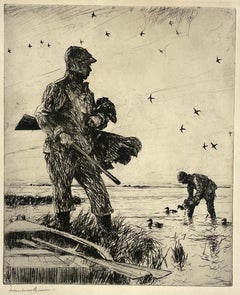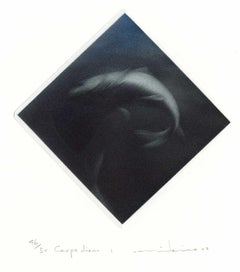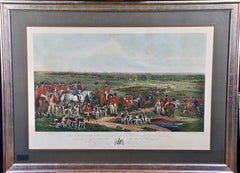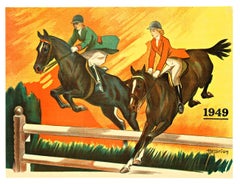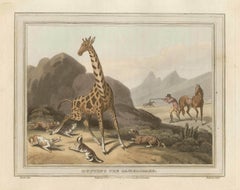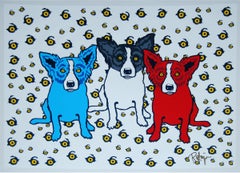People Animal Prints
to
333
861
295
348
137
89
Overall Width
to
Overall Height
to
562
317
140
92
67
39
24
20
18
16
11
2
1
1
63
62
43
20
20
214
224
983
314
6
13
42
49
48
58
91
260
114
105
206
939
738
50
2,728
1,735
1,460
1,067
831
550
491
445
444
401
347
344
328
244
232
190
181
159
142
141
654
561
300
171
97
188
659
806
664
Art Subject: People
WINTER WILDFOWLING
By Frank Benson
Located in Portland, ME
Benson, Frank. WINTER WILDFOWLING. Etching, 1927. Paff 265. Edition of 150. Signed in pencil, lowwer left. 11 7/8 x 9 7/8 inches (plate), 14 1/2 x 12 1/2 inches (sheet). Printed on W...
Category
1920s Figurative Prints
Materials
Etching
Carpe Diem I
Located in New Orleans, LA
this impression is #46 from edition of 50
Mezzotint artist Mikio Watanabe was born in 1954 in Japan and currently lives in France. He is most known for his elegant, evocative black ...
Category
Early 2000s American Modern Animal Prints
Materials
Mezzotint
$146 Sale Price
41% Off
Her Majesty's Stag Hounds on Ascot, A Colored 19th Century British Hunting Scene
Located in Alamo, CA
"The Meeting of Her Majesty's Stag Hounds on Ascot Heath" is a large colorful mezzotint engraving of an extensive British hunting scene. It was created by Sir Francis Grant...
Category
1830s Landscape Prints
Materials
Engraving, Mezzotint
Original Horse Jumping Steeple Chase 1949 Equestrian vintage poster
Located in Spokane, WA
Original linen backed 1949 International Jumping Steeple Chase Van Gent poster. The events were held at the Royal Cercle Equestre Gent; at the Feestpaleis
The Royal Cercle Eque...
Category
1940s American Realist Animal Prints
Materials
Lithograph
Hunting the Camelopard (Giraffe), antique African hunting engraving print, 1813
Located in Melbourne, Victoria
Colour aquatint after Samuel Howitt (1756/7-1822).
From Samuel Howitt's 'Foreign Field Sports' Samuel Howitt was an English painter, illustrator and etch...
Category
Early 19th Century Naturalistic Animal Prints
Materials
Aquatint
Oh Say Can You See White - Signed Silkscreen Print Blue Dog
Located in Mount Laurel, NJ
This Blue Dog work consists of a white background with various sizes of Blue Dog soulful yellow eyes and 3 dogs: 1 white & black, 1 red, and one blue. All dogs...
Category
1990s Pop Art Animal Prints
Materials
Screen
If You Ever Leave Me I'm Coming With You
Located in Nottingham, GB
Hand embellished print on paper
Edition of 18
This incredible painting would make a wonderful statement piece for a feature wall. and it would also be a great investment piece, as ...
Category
2010s Pop Art Animal Prints
Materials
Archival Paper, Color
Angel Baby
Located in Pembroke Pines, FL
Artist: George Rodrigue
Title: Angel Baby
Year: 2000
Dimensions: 20in. by 16in.
Edition: from the rare limited edition of 150
Medium: Original serigraph on paper
Condition: Excellent...
Category
Early 2000s Pop Art Animal Prints
Materials
Screen
$2,450 Sale Price
30% Off
The Bug - Original handsigned lithograph
By Corneille
Located in Paris, IDF
Corneille
The Bug, 1999
Original lithograph
Handsigned
Numbered EA /25
On vellum 63 x 46 cm (c. 25 x 18 inch)
Excellent condition
Category
1990s Surrealist Animal Prints
Materials
Lithograph
SHARE
By KAWS
Located in Washington, DC
Artist: KAWS
Title: SHARE
Medium: Screenprint on Stonehenge gray paper
Year: 2021
Edition: 184/500
Framed Size: 28" x 24"
Sheet Size: 20" x 16"
Signed: Hand signed and numbered in pe...
Category
2010s Figurative Prints
Materials
Screen
$7,995
TROUBLE AT WALNUT RIDGE Signed Lithograph, Farm Country, Green Hills, Horses
By Jim Buckels
Located in Union City, NJ
The limited edition lithograph TROUBLE AT WALNUT RIDGE is a stylized rural landscape; a visual story depicting an expanse of farm country with rolling green hills, a turquoise blue r...
Category
1980s Contemporary Landscape Prints
Materials
Lithograph
Cena Ultima (Guinea Vultures stand for apostles in this version of Last Supper)
Located in New Orleans, LA
Sharon Augusta Mitchell created "Cena Ultima" as if guinea vultures were the apostles in a "last supper" pose arrayed around a carcass in an edition of 100. This is impression #9 fr...
Category
1990s Contemporary Animal Prints
Materials
Drypoint, Etching, Aquatint
Le Singe à l'électronique, by Pierre-Yves Trémois
Located in Palm Springs, CA
Pierre-Yves Trémois’s Le singe à l’électronique (1976) merges scientific imagery with primal instinct, juxtaposing a pensive baboon beside circuit-like engravings and a serene human ...
Category
1980s Figurative Prints
Materials
Engraving, Etching
Nocturne
Located in Dallas, TX
David Everett was born in Beaumont, Texas, and received both his B.F.A. and M.F.A. from The University of Texas in Austin. Valley House began showing his multi-articulated, painted w...
Category
1990s Contemporary Animal Prints
Materials
Woodcut
"Lion Tamer" framed signed lithograph by Alexander Calder. Edition EA of 100.
Located in Boca Raton, FL
"Lion Tamer" lithograph by Alexander Calder. Hand-lettered EA in lower left front corner. Hand-signed Calder in lower right front corner. From an ed...
Category
1970s Modern Animal Prints
Materials
Lithograph
Innocent Mrs. Cat In The Court - Lithograph by J.J Grandville - 1852
Located in Roma, IT
Innocent Mrs. Cat In The Court is an original lithograph on ivory-colored paper realized by J.J. Grandville from Scènes de la vie privée et publique des animaux, 1852. Published by M...
Category
1850s Modern Animal Prints
Materials
Paper, Lithograph
Meanwhile Back at the Ranch, American Western Art Lithograph by Duane Bryers
By Duane Bryers
Located in Long Island City, NY
Duane Bryers, American (1911 - 2012) - Meanwhile Back at the Ranch, Year: 1980, Medium: Lithograph, signed and numbered in pencil, Edition: 300, AP, Size: 21 in. x 27.5 in. (53.3...
Category
1980s American Realist Animal Prints
Materials
Lithograph
Music, Afresco, Horse Portrait
Located in New York City, NY
Raphael Macek
Music, 2020
Afresco series
Large-scale photograph from the Equine Beauty series.
The legendary and complex relationship between humans and horses is an enduring one. ...
Category
2010s Contemporary Portrait Photography
Materials
Plexiglass, Archival Pigment
MAGENTA HORSE, THREE GEISHAS Signed Lithograph, Asian Women, Horse, Parrots
By Walasse Ting
Located in Union City, NJ
MAGENTA HORSE, THREE GEISHAS is an original lithograph printed using hand drawn lithography techniques on archival Somerset printmaking paper, 100% acid free, by the renowned Chinese born artist Walasse Ting (DING XIONGQUAN, Chinese, 1929-2010). Ting's use of bold colors and expressive calligraphic brush drawn forms convey vivid life energy. He is well known for his colorful images of women, flowers, fish, parrots and horses and was associated with artists Karel Appel, Asger Jorn, and Pierre Alechinsky, members of the avant-garde group called COBRA. Throughout his artistic life, Ting imbued his passion and spirit into his paintings, poetry and sculpture. MAGENTA HORSE, THREE GEISHAS is a freely expressed Chinese Ink Brush drawing depicting a colorful magenta horse with dark purple black mane and tail standing with three lovely Asian women...
Category
1980s Contemporary Figurative Prints
Materials
Lithograph
$1,280 Sale Price
21% Off
Veterinarian, Animal Lover - Original etching, Handsigned & Numbered /80
By Miguel Conde
Located in Paris, IDF
Miguel CONDÉ (1939-)
Veterinarian, Animal Lover, 1981
Original etching
Signed in pencil
Numbered / 80 copies
On vellum, 24 x 16.5 cm (c 10 x 6.5 in)
Excellent condition
Category
1980s Modern Animal Prints
Materials
Etching
Sir Cat by Deming King Harriman, animal art, fish, paper, print
Located in Jersey City, NJ
"Sir Cat", 2019, digital collage, print, cat, victorian, figurative, Digital Painting and Drawing / Animals / Surrealistic / Dark Colors / Portrait
Category
2010s Contemporary Figurative Prints
Materials
Digital
Le Cirque (The Circus) II
Located in San Francisco, CA
This artwork titled "Le Cirque (The Circus) II" is an original colors lithograph on Arches paper by noted French artist Camille Hilaire, 1916-2004. It is hand signed and inscribed C/...
Category
Late 19th Century Impressionist Figurative Prints
Materials
Lithograph
Baj Chez Picasso 2, Cubist Aquatint Etching by Enrico Baj
By Enrico Baj
Located in Long Island City, NY
Artist: Enrico Baj, Italian (1924 - 2003)
Title: Baj Chez Picasso 2
Year: 1969
Medium: Aquatint Etching, Signed and numbered in pencil
Edition: 86/100
Image Size: 15 x 22 inches...
Category
1960s Cubist Animal Prints
Materials
Etching, Aquatint
Les Courses -L'obstacle/de coté Horse Race, Pointillist style Equestrian print
Located in Spokane, WA
Colorful Lithograph of Horse Race – Jockey on Norse No. 6 by Serge Medjisky, original poster: Linen-backed printer's proof without text of the horse race. In the lower right are the ...
Category
1970s Impressionist Animal Prints
Materials
Lithograph
Mike Mitchell - Lucy - Contemporary Artist
Located in Asheville, NC
Mike Mitchell - Lucy - Contemporary Artist
Edition Details:
Year: 2020
Class: Art Print
Status: Official
Released: 07/03/20
Technique: Giclee
Paper: Cot...
Category
2010s Contemporary Animal Prints
Materials
Giclée
Good Night Mr. Wolf - Original Lithograph by J.J Grandville - 1852
Located in Roma, IT
Good Night Mr. Wolf - Animal Fable is an original lithographs on ivory-colored paper realized by J.J. Grandville from Scènes de la vie privée et publique des animaux, 1852. Published...
Category
1850s Modern Animal Prints
Materials
Paper, Lithograph
A Burro Train, New Mexico
By Peter Moran
Located in San Francisco, CA
This artwork titled "A Burro Train, New Mexico" 1880 is an original etching on Laid paper by noted British/American artist Peter Moran, 1841-1914. It is signed in the plate as issue. The plate mark (Image) size is 9.15 x 6.5 inches, framed size is 14.75 x 18.75 inches. It is framed in a wooden silver frame, with light grey matting. It is in excellent condition, especially considering the age. I like to mention that example of this particular etching is held in the following museums, including, The Toledo Museum Of Art, Toledo, The British Museum, London and The Smithsonian Museum Of Art, Washington D.C. It was also illustrated in American Art Review, volume #2 1881, page 163.
About the artist:
The younger brother of Thomas Moran, Peter Moran was a painter-etcher best known for his Romantic sensibility and landscape compositions incorporating animals. The Moran family immigrated to the United States from England in 1844, when Peter was three. He began his artistic career as an apprentice to a lithographic firm and eventually studied painting with his brothers Edward and Thomas. He was influenced by the animal paintings of Rosa Bonheur and Constant Troyon and visited England in 1863 to see those of Edwin Landseer.
Moran took up etching in 1874, using that medium to record genre scenes that he observed while traveling in New Mexico and Arizona in 1881 on an ethnographic expedition to study Pueblo Indian culture. He later returned to the Southwest in 1890 as an artist for the Bureau of Indian Affairs.
In 1882, Moran joined Henry R. Poore, an artist friend, on a visit to Taos Pueblo where the two were given a room and spent a week watching the activities associated with the harvest. Poore recounted the details of their travels in an article titled "A Harvest with the Taos Indians...
Category
Late 19th Century American Realist Animal Prints
Materials
Etching
Original Gene Autry Gold Mine in the Sky US 1-sheet linen backed movie poster
Located in Spokane, WA
Original Gene Autry Gold Mine in the Sky linen-backed original vintage movie poster. The poster does show some foxing on the original theatrical fold marks. Republic Pictures. ...
Category
1940s American Modern Portrait Prints
Materials
Lithograph
Jockey Before the Horse Race - Original wooodcut, Handsigned & numbered /160
Located in Paris, IDF
Pierre LISSAC (1878-1955)
Jockey Before the Horse Race, 1926
Original woodcut
Handsigned in pencil
Numbered /160
On vellum 32.5 x 25.5 cm (c. 13 x 10 in)
Bears the blind stamp of th...
Category
1920s Modern Animal Prints
Materials
Woodcut
Polar Bears, Expressionist Screenprint by LeRoy Neiman
By LeRoy Neiman
Located in Long Island City, NY
Artist: LeRoy Neiman, American (1921 - 2012)
Title: Polar Bears
Year: 1979
Medium: Screenprint, signed and numbered in pencil
Edition: 214/300
Image Size: ...
Category
1980s American Impressionist Animal Prints
Materials
Screen
Horseback Rider at the Great Pyramid of Giza, Surrealist Print
Located in New York, NY
Mystery Artist
Untitled (Great Pyramid), c. late 20th/early 21st century
Possibly C-Print or Lithograph?
Sight: 9 1/2 x 9 1/2 in.
Framed: 13 x 13 x 1 1/8 in.
Signed lower left
This...
Category
21st Century and Contemporary Surrealist Landscape Prints
Materials
C Print
Le Cirque (The Circus) IV
Located in San Francisco, CA
This artwork titled "Le Cirque (The Circus) IV" is an original colors lithograph on Arches paper by noted French artist Camille Hilaire, 1916-2004. It is hand signed and inscribed I/...
Category
Late 19th Century Impressionist Figurative Prints
Materials
Lithograph
Eagle Angels, by Yuji Hiratsuka
Located in Palm Springs, CA
Signed and numbered from the edition of 15. Printed on Chine colle. Image of two Eagles dressed as angels, celegrating a beautiful landscape under a smilin...
Category
2010s Contemporary Landscape Prints
Materials
Intaglio
'Cheval de Mecklembourg' — 19th-Century French Romanticism
Located in Myrtle Beach, SC
Théodore Géricault 'Cheval de Mecklembourg' (Mecklembourg Horse), lithograph, 1822, 2nd state of 4, Delteil 47. Signed in the matrix 'Gericault', lower left. Published by Godefroy En...
Category
1820s Romantic Animal Prints
Materials
Lithograph
Apple Dream, Surrealist Lithograph by Robert Beauchamp
Located in Long Island City, NY
Robert Beauchamp, American (1923 - 1995) - Apple Dream, Year: 1980, Medium: Lithograph, signed and numbered in pencil, Edition: AP 25, Size: 25.5 in. x 33 in. (64.77 cm x 83.82 cm)
Category
1980s Surrealist Animal Prints
Materials
Lithograph
Mayuka Yamamoto - Sitting Bear, 2022
Located in Central, HK
Mayuka Yamamoto
Sitting Bear, 2022
Lithograph in colors
27 3/5 × 21 3/10 in 70 × 54 cm
Edition of 75
Signed and numbered
Contact us for the edition nu...
Category
2010s Figurative Prints
Materials
Paper
Thoroughbred, American Realist Lithograph by Mel Hunter
By Mel Hunter
Located in Long Island City, NY
Mel Hunter, American (1927 - 2004) - Thoroughbred, Year: 1977, Medium: Lithograph, signed and numbered in pencil, Edition: 18/500, Size: 22 x 29.5 in. (55.88 x 74.93 cm), Descrip...
Category
1970s American Realist Animal Prints
Materials
Lithograph
Guet-Apens, par Gill; Cover Illustration from L'Eclipse, 17 March, 1872
By André Gill
Located in Middletown, NY
Paris: L'Eclipse, 1872.
Woodcut engraving with handcoloring on light-weight wove paper, 13 3/4 x 11 5/8 inches (347 x 294 mm), margins trimmed. Illustrated in Histoire de la révolut...
Category
19th Century French School Figurative Prints
Materials
Watercolor, Woodcut
Shepherdess and her Sheep - Original wooodcut, Handsigned & Numbered
Located in Paris, IDF
Henri AMEDEE-WETTER (1869-1929)
Shepherdess and her Sheep, 1920
Original woodcut
Handsigned in pencil
Numbered /105
On vellum 32.5 x 25.5 cm (c. 13 x 10 in)
Bears the blind stamp of...
Category
1920s Modern Animal Prints
Materials
Woodcut
Ass and the Lion Hunting, antique animal fable etching by Samuel Howitt
Located in Melbourne, Victoria
Original antique etching by Samuel Howitt (1756-1822) . C1810. Published by Edward Orme.
An early 19th century etching by Howitt from a series depicting ...
Category
Early 19th Century Naturalistic Animal Prints
Materials
Engraving, Etching
Mouse and Chair
By Donald Saff
Located in Middletown, NY
Etching with aquatint on white wove paper with a deckle edge, 23 1/2 x 17 1/2 inches (598 x 317 mm); sheet 30 x 22 1/2 (762 x 571 mm), full margins. Signed and numbered 20/50 in penc...
Category
Late 20th Century American Modern Animal Prints
Materials
Handmade Paper, Etching, Aquatint
Man in the Forest 1980 Large Signed Screen Print
Located in Rochester Hills, MI
Mark Sabin
Man In The Forest - 1980
Print - 26'' x 34'' in
Edition: signed in pencil and marked 234/250
Mark Sabin is a fantasy painter, blending elements in a juxtaposition that ...
Category
1980s Folk Art Animal Prints
Materials
Screen
$360 Sale Price
20% Off
Lithograph Lady Rider Woman on a Horse Marie Laurencin French Post Impressionist
Located in Surfside, FL
Marie Laurencin (French, 1883-1956)
Lithograph of a colored pencil drawing depicting a woman wearing a hat and riding horseback side saddle,
Edition "37/115" to lower left and hand signed "Laurencin" in pencil to lower right, with a cloth mat and housed in a silvered wood frame.
Dimensions: Image, 12" H x 16" W; frame, 19.75" H x 23.5" W x 1.5" D.
Marie Laurencin (1883 – 1956) was a French painter and printmaker. She became an important figure in the Parisian avant-garde as a member of the Cubists associated with the Section d'Or.
Laurencin was born in Paris, where she was raised by her mother and lived much of her life. At 18, she studied porcelain painting in Sèvres. She then returned to Paris and continued her art education at the Académie Humbert, where she changed her focus to oil painting.
During the early years of the 20th century, Laurencin was an important figure in the Parisian avant-garde. A member of both the circle of Pablo Picasso, and Cubists associated with the Section d'Or, such as Jean Metzinger, Albert Gleizes, Robert Delaunay, Henri le Fauconnier and Francis Picabia, exhibiting with them at the Salon des Indépendants (1910-1911) and the Salon d'Automne (1911-1912), and Galeries Dalmau (1912) at the first Cubist exhibition in Spain. She became romantically involved with the poet Guillaume Apollinaire, and has often been identified as his muse. In addition, Laurencin had important connections to the salon of the American expatriate and lesbian writer Natalie Clifford Barney. She had relationships with men and women, and her art reflected her life, her "balletic wraiths" and "sidesaddle Amazons" providing the art world with her brand of "queer femme with a Gallic twist."
Laurencin's oeuvre include painting, watercolor paintings, drawing, and prints. She is known as one of the few female Cubist painters, with Sonia Delaunay, Marie Vorobieff, and Franciska Clausen...
Category
Mid-20th Century Post-Impressionist Animal Prints
Materials
Lithograph
The Four Seasons - Winter, original, contemporary, landscape, print, silkscreen
Located in Deddington, GB
Silkscreen
Image Size H 50 x 66cm
Framed Size H 73 x 88cm
Edition of 100
Image size:
Height: 50cm (19.69 in)
Width: 66cm (25.98 in)
Complete size of sheet (sheet sizes may vary)
He...
Category
2010s Contemporary Animal Prints
Materials
Paper
"Our time", 1977 original linocut signed limited edition 24x18in Cuban Latin art
Located in Miami, FL
Ernesto Garcia Peña (Cuba, 1949)
'Our time" (from Porfolio Grabados Cubanos)', 1977
linocut print on paper Canson 320 g.
23.6 x 17.6 in. (59.8 x 44.6 cm.)
Edition of 200
Ref: GAE-309...
Category
1970s Contemporary Animal Prints
Materials
Paper, Engraving, Etching, Aquatint, Screen, Linocut
Pangas Launch from Punta Lobos, by Jos Sances
Located in Palm Springs, CA
Medium: 8 color Screenprint
Year: 2023
Image Size: 16 × 32 inches
Edition of 18
Pangas Launch from Punta Lobos by Jos Sances is a vivid contemporary woodcut that captures the tensio...
Category
2010s Contemporary Animal Prints
Materials
Screen
Mariners, Renegades and Castaways, by Jos Sances
Located in Palm Springs, CA
Medium: 8 color Screenprint
Year: 2015
Image Size: 36 × 18 inches
Edition of 11
Mariners, Renegades, and Castaways by Jos Sances revisits the brutal realities of nineteenth-century ...
Category
2010s Contemporary Animal Prints
Materials
Screen
Finland Bear Hunting, aquatint engraving hunting snow print, 1813
Located in Melbourne, Victoria
'Finland Bear Hunting'
Colour aquatint by Mathew Dubourg (1786-1838) after Manschirch.
From Samuel Howitt's 'Foreign Field Sports'. Samuel Howitt was an English painter, illustrato...
Category
Early 19th Century Naturalistic Animal Prints
Materials
Aquatint
Woman With Horse - Lithograph by Enzo Assenza - 1970s
Located in Roma, IT
Woman With Horse is an artwork realized by Enzo Assenza.
Print in lithograph technique.
Hand-signed by the artist in pencil on the lower right corner.
...
Category
1970s Contemporary Animal Prints
Materials
Lithograph
Playmates, mezzotint of child and cat by Cousins after Hugues Merle
By Samuel Cousins
Located in Melbourne, Victoria
Hugues Merle was a French painter who mostly depicted sentimental or moral subjects. Samuel Cousins was a highly regarded mezzotint engraver.
350mm by 2...
Category
Late 19th Century Victorian Figurative Prints
Materials
Mezzotint
St. George and the Dragon after Raphael
Located in Fairlawn, OH
St. George and the Dragon after Raphael
Engraving, 1885
Unsigned, proof before letters
A engraving after a painting by Raphael (c.1504-05) now in the Musée du Louvre, Paris (inv. no....
Category
1880s French School Animal Prints
Materials
Engraving
Latin American Judaica Conceptual Chassidic Art Modern Woodcut Luis Camnitzer
Located in Surfside, FL
Luis Camnitzer and Martin Buber (1878-1965),
New York: JMB Publishers Ltd, 1970.
Printed at The New York Graphic Workshop.
Hand signed on Arches paper. (Edition 24/100, numbered on Justification page)
Woodblock prints based on folktales from the Hasidic Jewish tradition in Eastern Europe, selected by Camnitzer from the early masters section of Buber’s Die chassidischen Bücher as translated by Olga Marx. German Expressionist style Jewish woodcuts...
Category
1970s Expressionist Figurative Prints
Materials
Woodcut
Frogs and Toad, Signed lithograph (AP), from Conspiracy: The Artist as Witness
By Jack Beal
Located in New York, NY
Jack Beal
Frogs and Toad, 1971
Hand signed in pencil by Jack Beal, annotated AP
One-color lithograph proofed by hand and pulled by machine from a zinc plate on Arches buff paper with deckled edges at the Shorewood Bank Street Atelier
Stamped, hand numbered AP, aside from the regular edition of 150 Stamped on reverse: COPYRIGHT © 1971 BY JACK BEAL, bears blind stamp
18 × 24 inches
Unframed
18 x 24 inches
Stamped on reverse: COPYRIGHT © 1971 BY JACK BEAL, bears distinctive blind stamp of publisher (shown) Publisher: David Godine, Center for Constitutional Rights, Washington, D.C.
Jack Beal's "Frogs and Toads" is a classic example of protest art from the early 1970s - the most influential era until today. This historic graphic was created for the legendary portfolio "CONSPIRACY: the Artist as Witness", to raise money for the legal defense of the Chicago 8 - a group of anti-Vietnam War activists indicted by President Nixon's Attorney General John Mitchell for conspiring to riot during the 1968 Democratic National Convention. (1968 was also the year Bobby Kennedy was killed and American casualties in Vietnam exceeded 30,000.) The eight demonstrators included Abbie Hoffman, Jerry Rubin, David Dellinger, Tom Hayden, Rennie Davis, John Froines, Lee Weiner, and Bobby Seale. (The eighth activist, Bobby Seale, was severed from the case and sentenced to four years for contempt after being handcuffed, shackled to a chair and gagged.) Although Abbie Hoffman would later joke that these radicals couldn't even agree on lunch, the jury convicted them of conspiracy, with one juror proclaiming the demonstrators "should have been shot down by the police." All of the convictions were ultimately overturned by the 7th Circuit Court of Appeals.
This lithograph has fine provenance: it comes directly from the original Portfolio: "Conspiracy The Artist as Witness" which also featured works by Alexander Calder, Nancy Spero and Leon Golub, Romare Bearden Sol Lewitt, Robert Morris, Claes Oldenburg, Larry Poons, Peter Saul, Raphael Soyer and Frank Stella - as well as this one by Jack Beal. It was originally housed in an elegant cloth case, accompanied by a colophon page. This is the first time since 1971 that this important work has been removed from the original portfolio case for sale. It is becoming increasingly scarce because so many from this edition are in the permanent collections of major museums and institutions worldwide.
Jack Beal wrote a special message about this work on the Portfolio's colophon page. It says, "In 1956, shortly after Sondra and I moved to New York, two friends were arrested and jailed for protesting air-raid drills. From them and their friends came our education. This work is dedicated to them and their families. "In Memory of Patricia McClure Daw and AL Uhrie" - This print was made for their children.
Jack Beal Biography:
Early in his career Walter Henry “Jack” Beal Jr. painted abstract expressionist canvases, because he believed it was “the only valid way to paint.” By the early 1960s he totally altered his approach and fully repudiated abstraction. Turning to representation, he painted narrative and figurative subjects, often enhanced by bright colors and dramatic perspectives.
Beal was born in Richmond, Virginia, and from 1950 to 1953 he attended the Norfolk Division of William and Mary College Polytechnic Institute, (now Old Dominion University) where he studied biology and anatomy. Shifting gears, he sought art training at the School of the Art Institute of Chicago where he focused on drawing, and met his wife, artist Sondra Freckelton. His art history instructor encouraged her students to paint in the manner of established artists, and to that end he frequented the Institute’s galleries. For Beal this was significant: “Until I saw pictures of real quality I had tended to think of painting as just so much self-indulgent smearing around, but when I saw masterpieces by Cézanne and Matisse, and other painters of similar stature, I was bowled over; suddenly I realized the force of art.”
After spending three years (1953–1956) at the Art Institute, Beal concluded his studies there without getting a terminal degree, thinking it was only useful if he wanted to teach, which, at the time, he did not. He also took courses at the University of Chicago in 1955 and 1956. During this period he married Freckelton, a fellow student and sculptor who began her career working in wood and plastic. Together they moved to New York’s SoHo District before its transformation from a wasteland of sweatshops and small factories into an arts district. They were active with the Artist Tenants Association which was instrumental in getting zoning laws changed so that artists could live and work in the well-lit lofts.
Embracing what came to be called “New Realism,” Beal initially painted an occasional landscape as well as earthy-toned still lifes which consisted of jumbled collections filled with personal objects. His signature style started with a series of female nudes—all modeled by Freckelton—based on Greek mythology. These were large canvases with flat paint surfaces, dramatic foreshortening, and unusual perspectives. He further enlivened them with vivid colors, stark lighting, and dynamic patterns derived from textiles and overstuffed furniture. He stopped painting nudes after two episodes. The first came as he was loading a canvas of his naked wife onto a truck in lower Manhattan; several laborers walked by and started to fondle and kiss the painting. On the one hand he felt his wife had been violated, while on the other he was pleased that his realism was so convincing. The second occurred after a solo exhibition in Chicago at which the reception had been sponsored by Playboy magazine. A few days later he was approached by a publicist and asked if Playboy bunnies could be photographed in front of his paintings. He refused.
Some portrait commissions came Beal’s way, but he preferred only portraying friends. More significant were four large murals on the History of Labor in America, the 20th Century: Technology (1975), which he undertook for the headquarters of the United States Department of Labor in Washington. Following a historical timeline, the themes were: colonization, settlement, nineteenth century industry, and twentieth century technology. The unveiling ceremony was attended by government officials and Joan Mondale, an arts advocate and wife of the vice-president. The reviewer for the Washington Post wrote enthusiastically: “They’re heartfelt and they’re big (each is 12 feet square). Their many costumed actors (the Indian, the trapper, the scientist, the hardhat, the capitalist in striped pants, the union maid, etc.) strike dramatic poses in dramatic settings (a seaside wood at dawn, an outdoor blacksmith’s forge, a 19th-century mill, a 20th-century lab). The lighting is theatrical. Beal’s compositions, with their swooping curves and bunched diagonals, are as complicated as his interwoven plots.” To accomplish the murals Beal assembled a team of assistants and models, much in the manner of Renaissance masters, which included artist friends and Freckelton. who by then was painting brightly colorful still lifes.
A second mural commission ensued from New York City’s Metropolitan Transit Authority for two twenty-foot long installations for the Times Square Interborough Rapid Transit Company subway station. Beal’s designs for The Return of Spring (installed in 2001, three days after the terrorist attacks in New York, Washington, DC and Philadelphia) and The Onset of Winter (installed in 2005), Beal captured the appearance of his models in an oil painting made to the scale of the intended mosaic. A collaboration with Miotto Mosaics, the canvases were shipped to the Travisanutto Workshop, in Spilimbergo, Italy, where craftsmen fabricated the design to glass mosaics. The Return of Spring depicted construction workers and other New Yorkers in front of a subway kiosk and an outdoor produce market and in The Onset of Winter, a crowd watches a film crew recording a woman entering the subway as snow falls against the city’s skyline. Harkening back to some of his early nudes based on Greek myth, Persephone, goddess of fertility and wife of Hades, appears in both. The symbolism is pertinent, since she spent six months each year below ground.
Although he disparaged teaching early on, Beal and Freckelton offered four summertime workshops on their farm in Oneonta, New York. He was an instructor at the New York Academy of Art, a graduate art school he helped to establish in 1982. Returning to Virginia, he taught at Hollins College...
Category
1970s Realist Animal Prints
Materials
Lithograph
Rupestral Painting - Original lithograph, Handsigned
Located in Paris, IDF
Jules CAVAILLES
Rupestral Painting
Original lithograph
Handsigned in pencil
Justified EA (artist proof)
On Arches vellum 36 x 20 cm (c. 14 x 8 in)
Excellent condition
Category
1960s Post-Impressionist Animal Prints
Materials
Lithograph
Salvador Dalí, "Le Cavalier et le Cerf" from Le Bestiaire de la Fontaine
Located in Chatsworth, CA
This piece is an original engraving with color added by pochoir by Salvador Dali. It is from Dali's suite of 12 original engravings entitled "Le Bestiaire d...
Category
1970s Surrealist Animal Prints
Materials
Engraving
$2,360 Sale Price
47% Off
Trapped, American Realist Lithograph by Harry Schaare
Located in Long Island City, NY
Harry Schaare, American (1922 - 2008) - Trapped, Year: Circa 1980, Medium: Lithograph, signed and numbered in pencil, Edition: 300, Size: 22 in. x 30 in. (55.88 cm x 76.2 cm), De...
Category
1980s American Realist Animal Prints
Materials
Lithograph
Leonor Fini, Two princesses and a bird, circa 1970
By Leonor Fini
Located in Saint Ouen, FR
Leonor Fini, Two princesses and a bird, circa 1970
Texte :
Rare print handsigned by surrealist artist Leonor Fini, inscreasingly esteemed with the movement of rediscovering art by w...
Category
1970s Animal Prints
Materials
Paper
Original Beauvais Chemin De Fer Du Nord SNCF vintage travel poster
Located in Spokane, WA
Original Chemin de fer du Nord "Beauvais" Vintage French Poster — Artist: Manceaux (c. 1920s). Size: 24.5" x 39.25" Linen Backed, Excellent Condition, Ready to Frame
Bring a touch of early 20th-century French elegance to your home or collection with this stunning, original Chemin de fer du Nord travel poster for the scenic city of Beauvais. Designed by the renowned artist Manceaux, this striking piece of railway history is a true treasure for collectors. Central to the image is a commanding view reminiscent of the Cathédrale Saint-Pierre de Beauvais—famous for its soaring Gothic choir. Tall, lancet windows and flying buttresses emphasize height. Delicately suggested tracery, pinnacles, and a luminous stone façade that captures warm light.
Classic French railway poster...
Category
1920s Art Nouveau Landscape Prints
Materials
Lithograph
Peasants in Front of a Castle - Original wooodcut, Handsigned
Located in Paris, IDF
Maurice BUSSET (1879-1936)
Peasants in Front of a Castle, 1928
Original woodcut
Handsigned in pencil
Numbered /160
On vellum 32.5 x 25.5 cm (c. 13 x 10 in)
Bears the blind stamp of ...
Category
1920s Art Deco Animal Prints
Materials
Woodcut
Matisse's Cat - Harmony in Red, contemporary, landscape, print, silkscreen
Located in Deddington, GB
Silkscreen
Image Size H 22 x 22cm
Framed Size H 47 x 45cm
Edition of 100
Additional information:
Screen print on Paper
Edition of 100
22 H x 22 W cm (8.66 x 8.66 in)
Sold unframed
...
Category
2010s Contemporary Animal Prints
Materials
Paper
